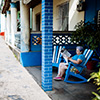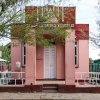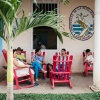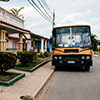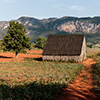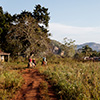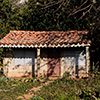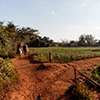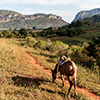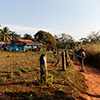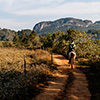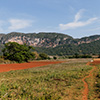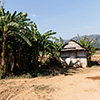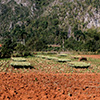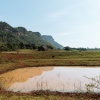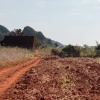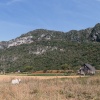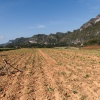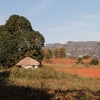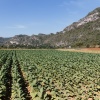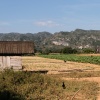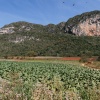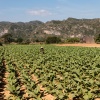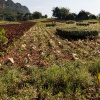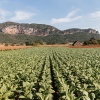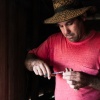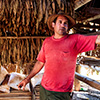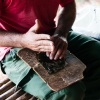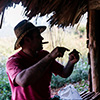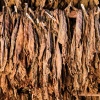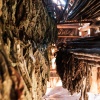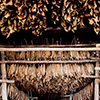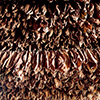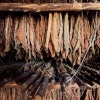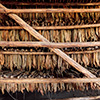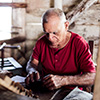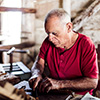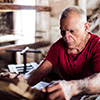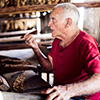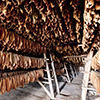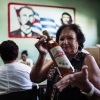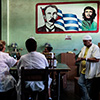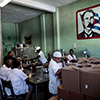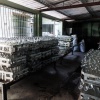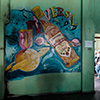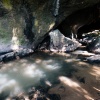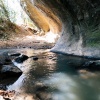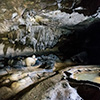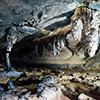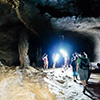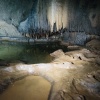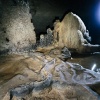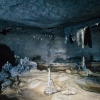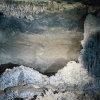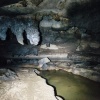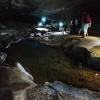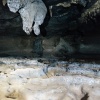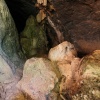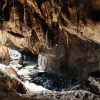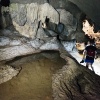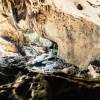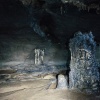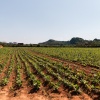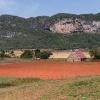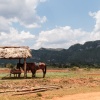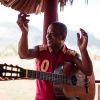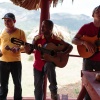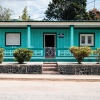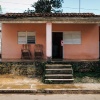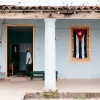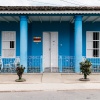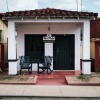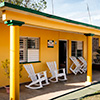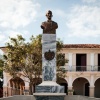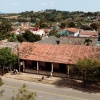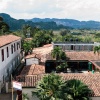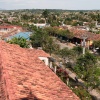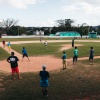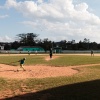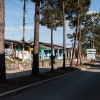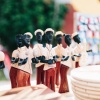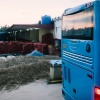Viñales – Tobacco and Dripstone Caves
The Viñales Valley (Valle de Viñales) in the West of Cuba is one of the island’s key growing areas for tobacco, the Cuban export hit number one. Its scenery belongs to the UNESCO cultural landscapes of humanity as is shaped by the surrounding Sierra de los Órganos, a range of karst mountains. The valley’s red soil and small tobacco fields are omnipresent companions when riding towards the mountains and its dripstone caves.
Friend on four Hooves
It is early in the morning. I can still feel the rum in my bones we had the evening before. My head feels like a hex nut. Grandpa Fernando, who drank a lot more than I, as fit as a Cuban fiddle though. Taciturnly I try to eat the heaps of food hostess Judi’s dishing up plate after plate shortly before 6 o’clock in the morning. Of course Judi makes her living from being a good host, on the other hand she quite splashes out when it comes to delighting her guests.
A honk sounds and a guy in a decrepit Moskvitch drives up. Together with a huge lunch pack 1.45 metres tall Judi crams me into the sharp-edged rusty Soviet metal chaise. My driver and companion answer to the name of Jordi. He brings me to his farm where already a horse waits in the wings to bring me out to the tobacco fields. Of course it would have been an option to walk all the way, but moving with some 20kg photo equipment in the scorching Cuban sun would have been no fun for sure.
The horses over here don’t look healthy, unfortunately. They definitely don’t have a good life. Though I am making a conscious decision in favour of a horse ride as it is surely much better for the animal to walk around instead of spending the day standing in a small and unventilated shack.
My hack is restive and rather seems to be a donkey in a horse costume as it gives a sh** about the usual riding and horse commands. Its owner though has somehow control over the animal. Must be the meta level they are communicating on…, as Jordi only needs to click his tongue or do some unutterable whistle sounds to direct the animal. Fascinating! At a hard saddle trot we roam through the morning vibe of Fincas and plantations, past cattle, farmers and tobacco plants.
We make a break and “park” the horses in the shade, right next to other horses. Yes, we are not the only ones being awake that early. In fact my ride through Viñales later becomes nothing but an orchestrated shopping tour and this stop is dedicated to the salesmanship of local tobacco farmers trying to persuade us into dozens of organic cigars. Yes, that word, that classification and trend has reached Cuba already as well.
I leave the saddle and descend the horse. It needs no 2 seconds and the hack starts peeing as if it drank 30 litres of ice tea before… A small urine yellow runlet shapes through the auburn soil and stops in front of Nico’s feet, who’s just saying goodbye to a group of Italians. Apparently his salesmanship worked as each Italian walks out with at least 25 cigars. Then Nico catches me. What promotional day trips with electric blankets for seniors are in Germany, are the horseback rides for cigars in Viñales.
Cigar booze cruise
Having the tarry-rough tasting fag between his lips, Nico rolls a cigar and tells us how excellent his organic cigars are, but how bad things go for tobacco farmers and how much they suffer. Well, Cuba doesn’t do really well from a western point of view, but on the other hand during my stay on Cuba I’ve never seen anyone dragging out a big wad of 50 US$ banknotes.
Professionally Nico trots out his lecture on tobacco and cigars. To prevent myself from getting profound squits I let my cigar disappear discretely under the open air table. I look at it, at the bottom and see many other stogy stubs lying on the ground, what reminds me optically of Berlin and its plenty of dog piles.
Fortunately Nico’s lecture is having an end as nobody’s buying and we carry on. Nimbly I swing himself onto the horse. Suddenly there’s a crack being followed by a 20 second sound. Somehow my drive must have unleashed something and the horse let one long off. The fart stinks terribly and doesn’t really remind of a plant eater. Unfortunately that odour sticks to my clothing and for the rest of my journey people approach me eye-rolling. Well, now I would have loved to have some of Nico’s tobacco-tarry smelling incense sticks for neutralisation. Nico, on the other hand, already worked on the next tourist group pattering the same story.
Making a short leap in time, I also visit other tobacco farms and a rum factory being located further south, in Pinar del Río. The farmers of Valle de Viñales and their plantations have to be understood as a cooperative, but the premises and plantations in the vicinity of the provincial capital Pinar del Rio are very often private property. Also over here farmers sing the song of the poor guy taking care of tobacco plants whose harvest gets taken away up to 90% by the bad government.
Attentive observers won’t miss though to notice gold chains, stately wristwatches plus clean and extraordinary clothing as well as the very good condition of farming equipment and the representative estate. Those observations paint a little different picture of tobacco farming, especially when compared with the non-wealthy rest of Cuba. Disregarding that debate, tobacco as well as cigars are nevertheless a unique and Cuba-typical cultural asset.
Back in the Viñales Valley we ride along the world’s Nicos, passing by other tobacco sales shows that are easy to spot by the group of horses being parked in the shade in front of a small barn or shack plus the Cuban guide waiting in front of it. The promotional journey with cigars instead of electric blankets is worth to be done though as at the end a miracle of nature awaits the traveller: a dripstone cave.
Cuba underground
Those Cuevas are no rarity in Valle de Viñales. The steep mountains with its rounded off peak are karst rocks, hence primarily made of limestone, what gets leached out by rain water leaving the caves behind. Large examples of Cuba’s dripstone caves are Cueva del Indio, Cueva de Santo Tomas or Cueva de San Miguel. I have a look at a smaller Cueva though.
Sympathetically seen my companion in the cave is only annoying as he answers each stop in the cave to capture a halfway decent photo with unfriendly Spanish shouts. His large LED panel appears like a light sabre from Star Wars. It literally cuts through the darkness and helps me to capture the colours of the cave. Down here the combination of fast lenses and latest high ISO technology show what is technically able.
At the end of the cave, that is at least part of a national park, hence enjoying stronger protection, the grumpy guide allows some dumbos to have a swim in the natural freshwater pool. Wow, really wow…, in a very negative way, as sun-lotioned generation McDonalds visits Cuba and may pollute pool and cave, but I am not allowed to stop for 3 seconds taking a photo.
Tourism can have quite a destructive character and those dumbos are a prime example as they leave behind a thick layer of sun lotion on the water that used to be clean before. That film of oil won’t degrade much as its ponding water that’s not exchanging much… That’s just poor and without respect for nature. Taking an underground bath reminds me of Anahulu Cave on Tonga, where locals are keeping tight watch over cave, water and nature; what is even a much greater pool fun in the end :-)
Having left the cave again, the small plantations, with their tobacco plants standing in file, immediately catch my eye. Against the background of the steep but rounded dark rocks as well as the one or other small tobacco barn Viñales’ scenery becomes quite an optical delight. The cherry on that cake of impressions is the contrast between auburn soil and green tobacco plants. Through some plantation farmers are having a stroll to dust off affectionately the lush green tobacco leaves.
Hard saddle penally coinciding with the stubborn horse causes quite a stress situation for rump as well as crown jewels. Fortunately it doesn’t take much time until in the middle of the Viñales Valley nowhere a small bar turns up. The Cuban sun scorched down on us the whole time, hence horse and rider need some refreshment; in my case I emptied a whole coconut at a record time. Quickly running out of coconuts the bar started to sell Mojito or rum. Usually Mojito is soda water with rum, but over here it’s rum with a pinch of soda water.
Some Muchachos turn up and work the crowd with live music. The drink’s hard mixture quickly becomes more effective and it doesn’t take much time until all tourists around slur the Cuban songs about Che Guevara & co. Singing, cheering and clapping with glazed eyes they celebrate the end of a Viñales horseback ride. But in the end that’s understanding among nations too.
The Viñales village
Back in Viñales – the small village has only one main road where restaurants line up to serve tourists – I notice many familiar faces I’ve seen already when being out with the horse. There is the fat US American woman again who actually needed two horses. I don’t fancy to make acquaintance with such people and walk around documenting the architecture and impression of the pretty ground-level houses Viñales is known for. A cute detail are the omnipresent rocking chairs. Each house has at least one and they are often matching the colour of the facade.
Of course Viñales has a church. At its entrance sits a hoary but very friendly and smiling grandma. After some flirting she permits me to have a look at the village from the tower. While climbing the ladder, she winks and jokes that I shouldn’t pull the bell please, as then she couldn’t quit on time as everyone would flock to the church thinking it’s time for a special service or someone has to be put to bed with a pick-axe and shovel :-)
Not long time ago, back in 2014, tourists had to sleep in the streets of Viñales as there only very few accommodation options. Raul Castro’s liberalisation of private economy let Casa Particulares called homestays spring up like mushrooms from a cowpat. Meanwhile Viñales doesn’t have 30 or 40 of them anymore, but a bustling 350 homestays, that are usually very hospitable and excellently equipped. Cuba changes, Cuba opens up.

